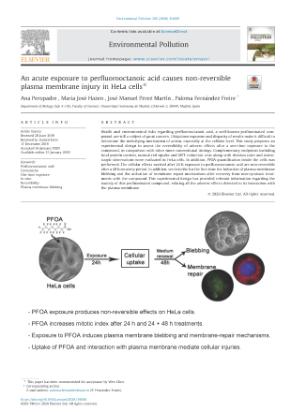
Perfluorooctanoic acid has been used widespread, during the last decades, in a number of consumer and industrial products. Although this compound has been subjected to extensive epidemiological and toxicological studies, limited data are available concerning its potential dermal toxicity in mammalian cells. In this study, we used a two-stage approach with relevant cytotoxicity endpoints including cell viability and proliferation, oxidative stress, DNA damage and cell senescence to assess the immediate and the long-lasting or delayed cytotoxicity caused by the compound in HaCaT keratinocytes. Our results suggest that a single exposure to perfluorooctanoic acid causes concentration-dependent changes in cell proliferation that were not restored during a 48 h recovery period. Furthermore, we demonstrate that a moderate treatment with this perfluorochemical causes persistent DNA damage, which ultimately leads to development of the senescence-associated secretory phenotype in HaCaT cells. This paper provides unprecedented data and insights regarding the cytotoxic effects of perfluorooctanoic acid in human cells that could be of special relevance for use in comparative in vitro-in vivo studies. Moreover, our findings highlight the importance of considering both the immediate and long-lasting or delayed cytotoxic responses caused by chemical exposure, to ensure the accurate identification of toxicity in cell-based systems.
Universidad Autónoma de Madrid © 2008 · Ciudad Universitaria de Cantoblanco · 28049 Madrid · Información y Conserjería: 91 497 43 31 E-mail: informacion.ciencias@uam.es Gestión de estudiantes de Grado y Posgrado: 91 497 8264 / 4329 / 4353 / 4349 / 6879 / 8362 E-mail: administracion.ciencias@uam.es